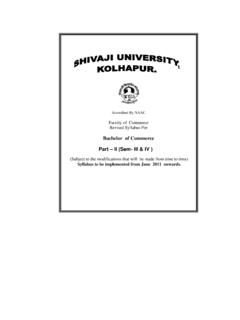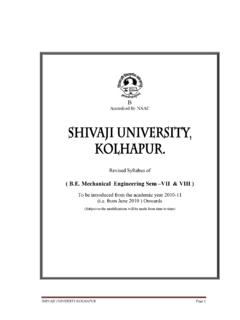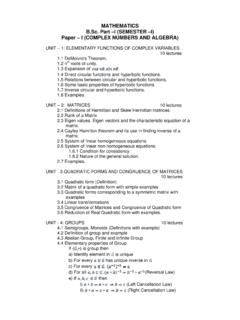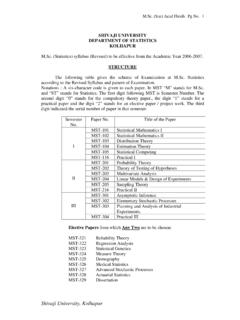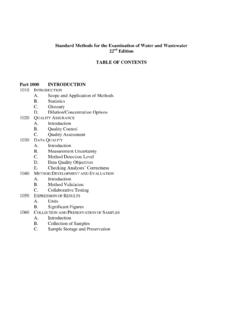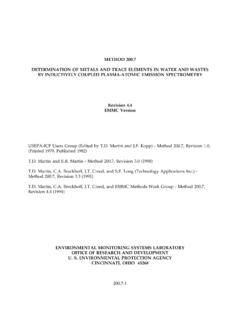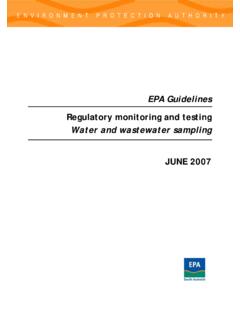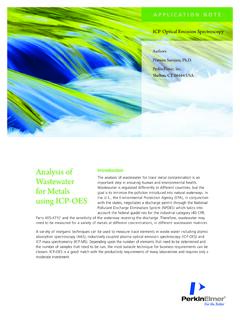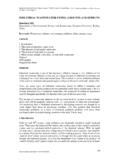Transcription of B.E. (Env.), Sem.- VIII
1 (Env.), VIII. MCQ for final exam by SUK for IWT. Unit-1. Question 1 Hot water after cooling is source of wastewater from------ a) Process b) Utility c) Domestic d) None of these Answer b) Utility 2 The main pollutant present in wastewater from cooling is --------- a) TDS. b) Acidity c) BOD. d) Waste Heat 3 In industries, the most polluted source of wastewater is from ---------- a) Process b) Utility c) Toilets d) Kitchen 4 The wastewater from softener regeneration is source of wastewater from----- a) Process b) Utility c) Domestic d) None of these 5 There are ------- main sources of wastewater in industries a) two b) three c) four d) six 6 ---- indicates physical characteristics of industrial wastewater a) Colour b) Solids c) Temperature d) All of these 7 -------- indicates chemical characteristics of industrial wastewater a) pH.
2 B) BOD. c) COD. d) All of these 8 -------- indicates biological characteristics of industrial wastewater a) viruses b) pathogens c) bacteria d) All of these 9 In India, the guidelines for effluent standards are issued by -------- a) Water Act, 1974. b) The EPA, 1986. c) CPCB. d) MoEFCC. 10 Effluent standards are a) Upper limit which should be exceeded b) Lower limit which should be exceeded c) Upper limit which should not be exceeded d) Always the lowest limit Answer c) Upper limit which should not be exceeded 11 The effluent standards have been defined to protect a) Streams & Rivers b) Sewers and STP.
3 C) Ground water d) All of these 12 --------- standards are specified in the consent granted to the industries a) Stream b) Effluent c) Drinking water d) None of these 13 The purpose of Water budget for industries is to ---- a) Reduce fresh water requirement b) Promote recycling c) Promote reuse d) All of these Answer d) All of these 14 Water budget is ------ for industries a) Mandatory b) Voluntary c) Optional d) Not required 15 ------- is benefit of preparing water budget a) Reduction in consumption of fresh water b) Reuse of wastewater c) Recycling of wastewater d) All of these 16 ------is the objective of industrial wastewater treatment a) Compliance with rules and regulation b) Promotion of reuse and recycling of wastewater c) Recovery of byproducts d) All of these 17 Reduction in cost of fresh water intake is -------- benefit of waste treatment a) Intangible b) Tangible c) Nonmonetary d) Not Answer b) Tangible 18 Cost saved on fine for non compliance is -------- benefit a) Primary tangible b) Secondary tangible c) Tertiary tangible d)
4 Non tangible 20 Increased value of adjacent properties due to proper treatment of wastewater is ------- benefit a) Primary tangible b) Secondary tangible c) Tertiary tangible d) Non tangible 21 Clean image of the industry is -------- benefits waste treatment a) Intangible b) Tangible c) Nonmonetary d) Not Answer a) Intangible 22 The order of waste minimization should be a) Reduce, reuse, recycle, recover b) Recover, reduce, reuse, recycle, c) Recycle, reduce, reuse, recover d) Reuse, reduce, recycle, recover Answer a) Reduce, reuse, recycle, recover 23 The ultimate goal of waste minimization should be------ a) No emission b) No waste generation c) Zero discharge d) Zero water Answer c) Zero discharge 24 Use of cooling water again for the same purpose is example of a) Reduction at source b) Recycling c) Recovery d) Reuse 25 Compared to sewage, the cost of treatment of industrial wastewater is normally ------- a) Lower b) Higher c) Same d) None of these 26 Compared to STP, the units needed at ETP are normally ------- a) More b) Less c) Same d)
5 None of these 27 Substitution of solvent-based paints with water-based paints is example of ------ a) Reduction at source b) Recycling c) Recovery d) Reuse 28 Use treated industrial wastewater for irrigation is example of ----- a) Reduction at source b) Recycling c) Recovery d) Reuse 29 Production of methane from treatment of industrial wastewater is ----- a) Recovery of energy b) Recovery of material c) Reuse d) Recycling 30 ------- is one of the techniques of reduction of volume of wastewater a) Classification and segregation b) All of these c) Reuse d) Recycling 31 -------- sample is collected during characterization survey a) Blank b) Mixed c) Integrated d) Composite Answer d) Composite 32 Characterization survey is done to check------ a) Quantitative and qualitative variation b) Quantitative variation c) Qualitative variation d) Flow variation Answer a) Quantitative and qualitative variation 33 ----- sample is suffient when there is no variation in quality of wastewater a) Composite b) Mixed c) Integrated d) Grab Answer d) Grab 34 ----- sample is useful when there is variation in quality of wastewater a)
6 Composite b) Mixed c) Integrated d) Grab Answer a) Composite 35 Composite sampling is done to find ----- a) Highest concentration of pollutants b) Average concentration of pollutants c) Lowest concentration of pollutants d) Highest and lowest concentrations of pollutants Answer a) Average concentration of pollutants 36 -------- of the sample must be measured on site a) BOD. b) COD. c) Temperature d) TDS. 37 Grab sample represents --------- a) Conditions prevailing at time of collection b) Average conditions c) Highest concentration d) Lowest concentration 38 For batch processes, the duration of composite sampling period should be ------- a) 12 hours b) 24 hours c) should cover at least one complete cycle d) None of these Answer c).
7 39 To maintain the integrity of the collected sample it is stored at a) 00 C. b) 200 C. c) 270 C. d) 40 C. 40 Concentrated sulfuric acid is used as preservative for analysis of -------- a) BOD. b) COD. c) Metals d) Nitorgen 41 Unit operations are based on use of ---------- for removal of pollutants a) Physical forces b) Chemical processes c) Biological processes d) None of these 42 Unit processes are based on use of ---------- for removal of pollutants a) Physical forces b) Chemical processes c) Biological processes d) Chemical & biological processes 43 Sedimentation is ----- a) Unit operation b) Primary treatment c) Physical treatment d) All of these Answer b) All of these 44 Coagulation is ------ a) Unit operation b) Secondary treatment c) Physical treatment d)
8 Chemical process 45 Flocculation is -------- a) Unit process b) Secondary treatment c) Physical treatment d) Chemical process 46 The target pollutant during secondary treatment is a) BOD. b) COD. c) TOC. d) O&G. Answer BOD. 47 UASB is -------- a) Anaerobic biological treatment b) Aerobic biological treatment c) Anaerobic chemical treatment d) Primary treatment 48 Membrane filtration is -------------- treatment a) Primary b) Secondary c) Tertiary d) Chemical Answer c) Tertiary 49 Advanced Oxidation processes are -------- treatment a) Physical b) Secondary c) biological d) Chemical 50 Primary treatment comprises of a) Only unit operations b) Only physical treatment c) Combination of unit operations and unit processes d) Only pH adjustment 51 Neutralization is type of -------- treatment a)
9 Physical b) Secondary c) Tertiary d) Chemical 52 Secondary treatment comprises of a) Only unit operations b) Only physical treatment c) Combination of chemical and biological processes d) Only biological treatment 53 Secondary settling tank is type of ----- a) Physical treatment b) Chemical treatment c) Combination of physical and biological treatment d) biological treatment 54 Primary treatment is provided -------- a) Before chemical treatment b) Before biological treatment c) Before physical treatment d) Before physico-chemical treatment 55 -------- are normally most expensive part of the treatment a) Primary treatment b) Secondary treatment c) Tertiary treatment d) Chemical treatment 56 Adsorption is part of a) Primary treatment b) Secondary treatment c) Tertiary treatment d) Chemical treatment 57 Nutrient removal treatment is ----------------- a) Primary treatment b) Physical treatment c) Tertiary treatment d) Unit operation 58 Equalization Tank can be designed for equalization of ------- a) Volume b) Strength c) Volume & strength both d)
10 None of these 59 Flow equalization is ------- a) Physical treatment b) Secondary treatment c) Tertiary treatment d) Chemical treatment 60 Equalization is very useful for --------- a) All of these b) Avoidance of shock load to biological treatment c) Imparting uniform characteristics to wastewater d) Improvement of the performance of ETP. 61 During biological treatment, O&G interfere with a) TDS removal b) Settling of sludge c) Oxygen transfer d) TSS removal Answer c) Oxygen transfer 62 The O&G can be present in ----- form a) Free or emulsified b) Free and floating c)

